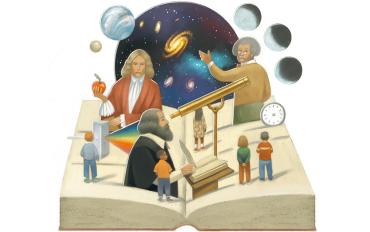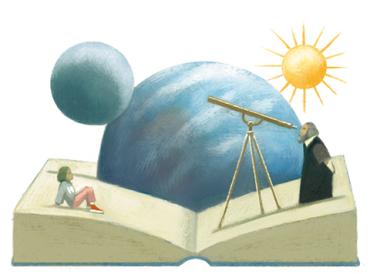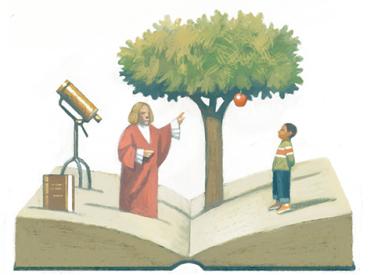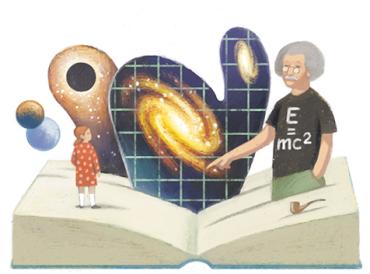More than a decade has passed since American Educator featured the work of Joy Hakim, a writer whose nonfictional accounts of history and science have long fascinated students and teachers alike. With the advent of the Common Core State Standards, and their strong emphasis on nonfiction, Hakim’s accounts may prove useful to educators seeking worthwhile content that both expands students’ background knowledge and sparks their imagination.
The following article introduces Hakim to those unfamiliar with her work (and also reacquaints those who are fans). She recounts her journey from newspaper reporter to children’s book author, while sharing her thoughts on the importance of narrative nonfiction in student learning. Throughout her career, Hakim has written stories rich in detail about figures such as Aristotle, Alexander the Great, Nicolaus Copernicus, Sir Isaac Newton, and many others. In the sidebar "Field Days for Farady and Maxwell," we give a glimpse of how she takes readers on a journey back in time by excerpting a chapter from her latest publication, Reading Science Stories, an e-book available on Amazon.com. This particular chapter tells the story of Michael Faraday and James Clerk Maxwell, whose efforts laid the foundation for “an electromagnetic revolution,” as Hakim eloquently writes.
–EDITORS
It was the 1980s,
and someone on the Virginia state school board, looking closely at a widely used high school textbook, was horrified by liberties the publisher had taken with Shakespeare. When the bard used a difficult word, the publisher substituted another, without any notation. So teachers were teaching Shakespeare, and students were reading Shakespeare, without knowing that they actually weren’t.
Board members checked other school texts. The state-approved American history text was, as students kept telling them, boring, really boring. No one read it gladly. The more the board looked, the duller the textbooks got. Some had errors. Energized, the Virginians invited leading textbook publishers to a meeting in Richmond to discuss what they now saw as a major education problem: commercial schoolbooks. Two national publications (Time and Newsweek) noted the upcoming session.
I was a newspaper reporter who had become an editorial writer at the Virginian-Pilot in Norfolk, and I volunteered to go to Richmond to cover the event because I thought it had the potential to impact American education. The publishers sent their sales representatives, not editorial staff. One perky rep, leather briefcase in hand, explained that Virginia had a textbook problem because its schools taught American history in seventh grade and the rest of the country chose eighth (or maybe it was vice versa). I shook my head in disbelief. A board member rolled her eyes.
Driving home, I did some thinking. Before I became a reporter, I’d been a classroom teacher. I taught elementary, middle, and high school classes, including special education. I also taught writing to high school English teachers for University of Virginia credit, and American literature at Tidewater Community College. As for American history, an op-ed piece I’d written on Thomas Jefferson for the Wall Street Journal had been well received.1 I thought if I took a year off from paying work, I could write a readable U.S. history book.
Ah, how little I knew about what I was getting into. It would be 10 years before I had a published book in hand. Meanwhile, I tumbled into a publishing world focused on profits, not on educational challenges. What happened next? I began writing stories from American history and testing those nonfiction stories in classrooms, eventually in six cities across the country. I was also paying neighborhood children to act as editors. Given salaries ($5 a read), they didn’t hold back.
I also got cogent comments from teachers and students in the six cities. A small grant allowed me to visit classrooms. In San Diego, the superintendent asked if he could test the book citywide. But I didn’t have a book; I had a manuscript for a book, which I was sending to schoolbook publishers. There were about 30 of them then (today, three mega-publishers control much of the school market).
Every publisher who saw the manuscript turned it down. It was enthusiasm from teachers and students that kept me writing. The book morphed into two volumes, then four; finally, I formatted it into 10 small chronological books, titled A History of US. I intended the books to teach reading, writing, and thinking skills as well as American history, and I didn’t want a behemoth text that would overwhelm young readers.
Eventually, Oxford University Press published A History of US; it was Oxford’s entry into the young adult market, and to everyone’s surprise, the books did well.2 Oxford produced excellent teaching manuals, and an educator team at Johns Hopkins University added innovative teaching materials that cross disciplines.
A young reader wrote a letter suggesting that I write about science next. When a second letter-writer asked the same thing, I paid attention. A teacher friend told me that hands-on science, which dominates in schoolrooms, isn’t enough. Children need to know the story behind an experiment if they are to understand and remember it. For me, science, like history, became a way to teach reading and thinking skills as well as subject matter.
There was still more to consider; I realized that even though we were living in the greatest scientific era ever, we as a population were scientifically illiterate. We were doing a poor job making our students aware of the big ideas that underlie our time. I saw myself among the illiterates. But as a newspaper reporter, I was trained to tackle and research any subject. I also knew how to find experts to back up my work. I soon developed an overwhelming thirst: to understand today’s science.
So I began writing to answer my own questions as well as those of potential readers, and after a few years, I had three books of science stories. Those books, Aristotle Leads the Way, Newton at the Center, and Einstein Adds a New Dimension, were published by Smithsonian Books and the National Science Teachers Association as a three-part series, The Story of Science.3 The books won a bunch of prizes, including a science book of the year award from USA Book News, and they will be available in e-book format this spring.
As for their classroom use, the books baffled some school authorities. Were they language arts, or history, or science? For me, they were all of those. During a visit to a Maryland school, I met four teachers—math, science, language arts, and history—all working together on a coordinated science-based curriculum. It was what I had intended.
Which brings us to the e-book excerpted on the right, Reading Science Stories. It’s a book meant to examine scientific ideas, to hone nonfiction reading skills, and also to be enjoyed across disciplines. At a time when the Common Core State Standards, and many educators, understand the value of nonfiction reading, it seems timely.
What about its readers? What age should they be? That’s a question I’m often asked. Quick answer: all my books seem to test at a fifth-grade reading level, as does most newspaper writing. But no one would confine newspapers to fifth-graders.
I see attempts to narrowly categorize school reading to specific age levels as shortsighted. The Adventures of Tom Sawyer can be read in third grade and in college seminars. My books turn up across that same spectrum of grades. It’s the teaching and the expectations that vary with different ages. Do you and your students enjoy the book? If so, feel free to read and teach it, no matter their age.
The chapter included in the sidebar, “Field Days for Faraday and Maxwell,” focuses on two little-known scientists, Michael Faraday and James Clerk Maxwell. In their 19th-century world, horses and muscles were major sources of power, as they had always been. But Faraday understood that the sun’s rays carry energy, and he figured out that it travels in alternating waves of electricity and magnetism. That insight needed to be expressed mathematically. Maxwell took Faraday’s intuition and turned it into four equations that power today’s world.
Without Faraday and Maxwell, there would have been no electrical or electronic revolutions, no relativity from Einstein. It’s hard to find historic figures that are more important. And for the most part, we haven’t told our children about them. Am I suggesting that you teach Maxwell’s equations? Or Einstein’s? Not unless you can (I can’t), but stories can help you teach their significance and imprint it in young minds. And those nonfiction stories will do something else. I believe they can impact reading scores. The thinkers behind the Common Core State Standards seem to agree, as do other educators.
In a report titled Choosing Blindly: Instructional Materials, Teacher Effectiveness, and the Common Core, the Brookings Institution says, “There is strong evidence that the choice of instructional materials has large effects on student learning—effects that rival in size those that are associated with differences in teacher effectiveness.”4
And whereas improving teacher quality “is challenging, expensive, and time-consuming,” according to the Brookings report, “making better choices among available instructional materials should be relatively easy, inexpensive, and quick.”5 Some education critics may blame teachers for declining reading scores, but I see dreary school reading materials as major culprits.
Which brings us back to textbooks: Einstein was coauthoring a physics textbook when his pal Max Born, also a Nobel Prize winner, wrote him a note that said, “To present a scientific subject in an attractive and stimulating manner is an artistic task, similar to that of a novelist or even a dramatic writer. The same holds for writing textbooks.”6
Artistic textbooks? Is that possible? Yes, it is. But today, many school texts are commercial ventures that are routinely ghostwritten. Publishers often put a professor’s name on the cover to help with sales. These formulaic books take a huge portion of school budgets, they help explain disappointing test scores, and they give nonfiction a bad image at a time when it has become the reading form of our time.* Textbooks should be the work of our best writers. David Saville Muzzey, a Barnard professor with the skills of a storyteller, made American history everyone’s favorite subject in the early 20th century with a text, An American History, that was widely read and anything but dull.7 Why aren’t our great writers writing school texts?
Perhaps because, in the past, schools routinely stacked books into two piles: fiction was labeled literature, and nonfiction was not. Yale’s wonderful writing guru William Zinsser had this to say on that subject: “Those of us who are trying to write well about the world we live in, or to teach students to write well about the world they live in, are caught in a time warp, where literature by definition consists of forms that were certified as ‘literary’ in the nineteenth century: novels and short stories and poems.”8
Fiction, according to my dictionary, is an invented story that includes literature, narrative, and creative writing. But nonfiction, with stories that are not invented, can be all of those.
No one wants schools to give up on fiction. First-graders really believe rabbits can talk; their middle school siblings understand that Harry Potter is fantasy but revel in the world he inhabits; and lucky high school readers experience the transformative thoughts that come with immersion in a great novel. There is no reason to eliminate those delights. What is needed is a balance that brings true stories into the literary fold, along with an awareness that reading informative writing takes different skills than reading fiction.
You read nonfiction to learn something you don’t know, so you need to pay attention in a way that often isn’t necessary with made-up stories. I almost always read a work of informative writing with a pencil or marker in hand, and I read it more than once and take notes if I want to retain it in my head.
Nonfiction demands much of the reader, and it returns the favor by stretching the mind. I’m encouraged by the Common Core State Standards. Adding narrative nonfiction to school booklists means exposing students to essential information about our world, along with some great writing. (Check out The Boys in the Boat by Daniel James Brown, or The Wright Brothers by David McCullough, for examples of absorbing nonfiction. If you teach physics, and your students can handle calculus, check out Spacetime Physics by Edwin Taylor and John Wheeler for a great textbook. It begins with a parable.)
Reading informational writing is usually tougher than reading fiction. It’s a skill that each of us develops for ourselves. We need to make that clear to students, helping them acquire different techniques and speeds for different materials, and understand that what works for one reader may not work for another. Something else: as readers, we need to evaluate and ask, “Is this book worth my time?” Maybe it isn’t.
Today, many schools surround students with books and let them make their own choices. That makes sense. It also makes them part of the reading process, especially if their reading leads to writing of their own.
Joy Hakim writes nonfiction books for children. A former teacher and journalist, she is the author of A History of US, a 10-volume series that was made into a PBS special called Freedom. This article is adapted from Hakim’s Reading Science Stories. Reading Science Stories is excerpted and adapted from The Story of Science by Joy Hakim, published by Smithsonian Books, and from other work she is writing about evolutionary biology, all rights to such other work being reserved by Ms. Hakim.
*For more on the history of content-poor curricula in the elementary grades, see “Content on the Cutting-Room Floor” in the Summer 2014 issue of American Educator.
Endnotes
1. Joy Hakim, “A Forgotten Fight for Religious Freedom,” Wall Street Journal, July 16, 1985.
2. Joy Hakim, A History of US, 10 vols. (New York: Oxford University Press, 1993).
3. Joy Hakim, The Story of Science, 3 vols. (Washington, DC: Smithsonian Books, 2004–2007).
4. Matthew M. Chingos and Grover J. Whitehurst, Choosing Blindly: Instructional Materials, Teacher Effectiveness, and the Common Core (Washington, DC: Brookings Institution, 2012), 1.
5. Chingos and Whitehurst, Choosing Blindly, 5.
6. W. F. Bynum and Roy Porter, Oxford Dictionary of Scientific Quotations (Oxford: Oxford University Press, 2005), 77.
7. David Saville Muzzey, An American History (Boston: Ginn and Company, 1911).
8. William Zinsser, On Writing Well, 6th ed. (New York: HarperCollins, 2001), 96–97.
[illustrations by Gianni De Conno]




